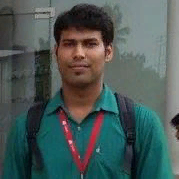
Sumeet Saurav
Work place: CSIR - Central Electronics Engineering Research Institute (CSIR-CEERI) Pilani - 333031, Rajasthan, India
E-mail:
Website:
Research Interests: Computer Graphics and Visualization, Computer Vision, Computer systems and computational processes
Biography
Sumeet Saurav is working as SRF in CSIR-Central Electronics Engineering Research Institute, Pilani, India - A Government of India Research Laboratory. His research interests are Computer Vision and VLSI Design. He received his M.Tech. in Advanced Semiconductor Devices from Academy of Scientific & Innovative Research (AcSIR), India. He is University rank holder in B.E.
Author Articles
Real-time Object Tracking with Active PTZ Camera using Hardware Acceleration Approach
By Sanjay Singh Ravi Saini Sumeet Saurav Anil Kumar Saini
DOI: https://doi.org/10.5815/ijigsp.2017.02.07, Pub. Date: 8 Feb. 2017
This paper presents the design and implementation of a dedicated hardware (VLSI) architecture for real-time object tracking. In order to realize the complete system, the designed VLSI architecture has been integrated with different input/output video interfaces. These video interfaces along with the designed object tracking VLSI architecture have been coded using VHDL, simulated using ModelSim, and synthesized using Xilinx ISE tool chain. A working prototype of complete object tracking system has been implemented on Xilinx ML510 (Virtex-5 FX130T) FPGA board. The implemented system is capable of tracking the moving target object in real-time in PAL (720x576) resolution live video stream directly coming from the camera. Additionally, the implemented system also provides the real-time desired camera movement to follow the tracked object over a larger area.
[...] Read more.Prototyping an Automated Video Surveillance System Using FPGAs
By Sanjay Singh Sumeet Saurav Chandra Shekhar Anil Vohra
DOI: https://doi.org/10.5815/ijigsp.2016.08.06, Pub. Date: 8 Aug. 2016
Because of increasing terrorist activities, the resolution of video cameras and the number of cameras deployed for surveillance are increasing exponentially – producing huge amount of video data. Manual analysis of this large volume of video data by human operators for crime scene and forensic analysis is neither reliable nor scalable. This has generated enormous interest in research activities related to automation of video surveillance systems which allows real-time automatic extraction and analysis of information from live incoming video streams and enables automatic detection and tracking of targets without human intervention. To meet the real-time requirements of automated video surveillance systems, very different technologies and design methodologies have been used in literature. These range from use of General Purpose Processors (GPPs) or special purpose Digital Signal Processors (DSPs) or Graphics Processing Units (GPUs) to Application Specific Integrated Circuits (ASICs) or Applications Specific Instruction Set Processors (ASIPs) or even programmable logic devices like Field Programmable Gate Arrays (FPGAs). FPGAs provide real-time performance that is hard to achieve with GPPs/DSPs, limit the extensive design work, time, and cost required for ASICs, and allow algorithmic changes in later stages of system development. Due to these features FPGAs are being increasingly used for prototyping automated video surveillance system quickly. In this paper we present the top level description of a complete automated video surveillance system along with the elaboration of different challenges/issues involved in its design and implementation, a comparative analysis of design methodologies and existing FPGA platforms, complete design flow for prototyping the FPGA-based automated video surveillance system, and details of various primary input/output interfaces required for designing smart automated video surveillance systems for future.
[...] Read more.Moving Object Detection Scheme for Automated Video Surveillance Systems
By Sanjay Singh Sumeet Saurav Chandra Shekhar Anil Vohra
DOI: https://doi.org/10.5815/ijigsp.2016.07.06, Pub. Date: 8 Jul. 2016
In every automated video surveillance system, moving object detection is an important pre-processing step leading to the extraction of useful information regarding moving objects present in a video scene. Most of the moving object detection algorithms require large memory space for storage of background related information which makes their implementation a difficult task on embedded platforms which are typically constrained by limited resources. Therefore, in order to overcome this limitation, in this paper we present a memory optimized moving object detection scheme for automated video surveillance systems with an objective to facilitate its implementation on standalone embedded platforms. The presented scheme is a modified version of the original clustering-based moving object detection algorithm and has been coded using C/C++ in the Microsoft Visual Studio IDE. The moving object detection results of the proposed memory efficient scheme were qualitatively and quantitatively analyzed and compared with the original clustering-based moving object detection algorithm. The experimental results revealed that there is 58.33% reduction in memory requirements in case of the presented memory efficient moving object detection scheme for storing background related information without any loss in accuracy and robustness as compared to the original clustering based scheme.
[...] Read more.Other Articles
Subscribe to receive issue release notifications and newsletters from MECS Press journals